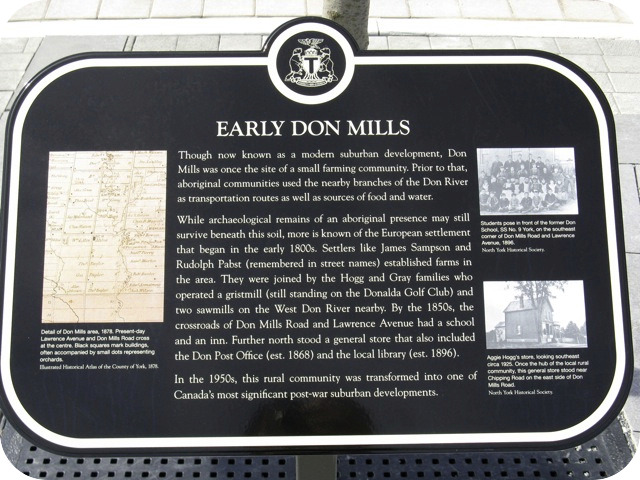Discover Toronto's history as told through its plaques
2004 - Now in our 14th Year - 2018
To see what's new on this site, you can visit the Home Page
Looking at this page on a smartphone?
For best viewing, hold your phone in Landscape mode (Horizontal)
Early Don Mills

Photo and transcription by contributor Wayne Adam - Posted May, 2009

Photo by contributor Sean Marshall - Posted April, 2009

Photo and transcription by contributor Wayne Adam - Posted May, 2009

Photo and transcription by contributor Wayne Adam - Posted May, 2009
This set of three historical plaques, erected by Heritage Toronto in 2009, are located in the central area of the Shops of Don Mills located at the southwest corner of Don Mills Road and Lawrence Avenue East. Here's what they say:
Coordinates: 43.734848 -79.344935 |
 |
Early Don Mills
Though now known as a modern suburban development, Don Mills was once the site of a small farming community. Prior to that, aboriginal communities used the nearby branches of the Don River as transportation routes as well as sources of food and water.
While archaeological remains of an aboriginal presence may still survive beneath this soil, more is known of the European settlement that began in the early 1800s. Settlers like James Sampson and Rudolph Pabst (remembered in street names) established farms in the area. They were joined by the Hogg and Gray families who operated a gristmill (still standing on the Donalda Golf Club) and two sawmills on the West Don River nearby. By the 1850s, the crossroads of Don Mills Road and Lawrence Avenue had a school and an inn. Further north stood a general store that also included the Don Post Office (est. 1868) and the local library (est. 1896).
In the 1950s, this rural community was transformed into one of Canada's most significant post-war suburban developments.
From Farmland to "New Town"
In the midst of a housing shortage after World War II, E.P. Taylor, one of Canada's most powerful businessmen, acquired over 800 ha of farmland here. From 1953 to 1965, Taylor's companies transformed the farmland into one of the world's most innovative "New Towns", complete with 28,000 residents, over 70 industries, one of Canada's earliest suburban shopping plazas, schools, and recreation facilities.
Don Mills was the first North American land development of its kind to be entirely planned and funded by the private sector. Its master plan was designed by Macklin Hancock in consultation with some of the world's leading urban planners. Centred around a common commercial and civic area, neighbourhoods are isolated from heavy traffic by looping roads and culs-de-sac. Light industry was welcomed on the edges of the plan.
In an effort to create a landmark Modernist community, careful attention was paid to everything from the architectural style and position of buildings to their exterior materials and colours. Existing trees were retained wherever possible and generous green space was provided.
The Don Mills Legacy
Don Mills has become one of the most discussed planned communities in Canadian history. Challenged, on the one hand, by critics of sprawling suburban development, it has also received praise from around the world for its attempt to create a fully functioning town where residents can live, work, and play.
The development's success inspired imitation. After Don Mills, large private developments became the norm, with developers assuming the costs for the construction of public infrastructure such as roads and services for water and sewage. The road system of traffic-calming culs-de-sac and looping streets, popularized here, became synonymous with the suburbs.
The central commercial core in which you stand has changed over the years, with a major redevelopment beginning in 2007. Don Mills' striking master plan remains largely intact - a landmark in urban planning.
Related webpages
Don Mills
Don River
E.P. Taylor
cul-de-sac
urban planning
Related Toronto plaques
Don Mills
Donalda Farm
Other Toronto plaques about mills
Early Mill Site
Gray Mill and Donalda Cattle Barn
Highland Creek Mills
The King's Mill
The Lost Village of Milton Mills
The Old Mill
Silverthorn Family and Mill Farm
This Millstone
Todmorden Mills
York Mills
More
Neighbourhoods, Villages and Towns
Here are the visitors' comments for this page.
> Posted September 16, 2012
It was great to read the history of Don Mills. I grew up in #1 Belton Road where my family moved in the early 50's. I remember riding my bike into the Don Valley and coming across old farm buildings. It was such a great place to flourish. My parents had an art studio in the original Don Mills Centre. I spent a lot of time there as well. Where the mall stands there were hills and we kids would toboggan down those hills during the winter. I have sweet memories and made lots of good friends in that community.
Valri Bromfield
Here's where you can send me a comment for this page.
Note: Your email address will be posted at the end of your comment so others can respond to you unless you request otherwise.
Note: Comments are moderated. Yours will appear on this page within 24 hours (usually much sooner).
Note: As soon as I have posted your comment, a reply to your email will be sent informing you.
To send me your comment, click [email protected].
Thanks
Webmaster
Note: If you wish to send me a personal email, click here.